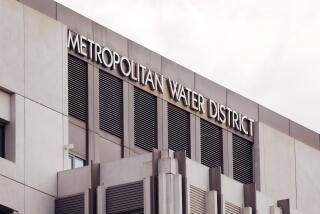We’ve come a long way in slaking SoCal’s thirst
Given the record dry weather in recent months, it is quite possible that Southern California will receive very little water from Northern California this year. Major reservoirs in the north are far below their normal levels for this time of year, with the two largest at only one-third of capacity. The Southland’s other major source of imported water — the Colorado River — is in the midst of its longest dry cycle in recorded history, bringing the Southwest closer to its first-ever supply restrictions.
Gov. Jerry Brown took an important step last week in declaring a drought and asking all Californians to cut their water usage by 20%. Residents throughout the state should heed his call. But Southlanders should also know that the situation here isn’t yet dire, and it doesn’t need to be if we are careful.
Why?
PHOTOS: Is Gov. Jerry Brown saving California or ruining it? The 9 big issues
The region has done two major things right since the dry cycles of the 1970s and early 1990s. First, Southern Californians have embraced conservation and dramatically lowered their water consumption, installing millions of low-flow toilets, shower heads and other appliances. Second, the region has developed new reservoirs and groundwater banks in the Southland and the San Joaquin Valley to store water in good times for use in bad.
Absent these investments, Southern California would now be in the throes of a historic water shortage. We are far from immune from this and future droughts, and we must continue to treat every drop of water as precious, approaching this drought as one state. But, in the Southland, we have learned a few hard lessons from previous droughts.
Behind the water that flows from the tap is a steadily evolving system of collecting, storing and delivering water. A generation ago, water managers expected imported supplies from Northern California and the Colorado River to meet two-thirds of the region’s demands, regardless of the weather. But when the historic 1987-92 drought triggered shortages, the Southland took water rationing as a wake-up call.
Regional water plans began focusing as much attention on conservation and lowering demand as they did on proposals to augment supply. The Metropolitan Water District of Southern California estimates that, through plumbing code reforms and more than $1 billion of investments in conservation and supply management — including financial incentives for product rebates, groundwater cleanup and other programs — the region has reduced its annual water consumption by 900,000 acre-feet. Water recycling has added an additional 300,000 acre-feet of new supply. And that’s a lot of water: Each acre-foot is nearly 326,000 gallons, about the amount used yearly by two typical Southland families.
Here’s another way to consider the effect of this investment. The largest ocean desalination facility in the Western Hemisphere is under construction in San Diego County. It will produce about 50,000 acre-feet of water annually. Had Southern California not embraced these investments in saving water and recycling over the past generation, and had it sought instead to meet increased demand solely through desalination, the region would need 18 such desalination facilities. That is roughly one large-scale desalination plant every three miles along the coast from Newport Beach to Marina del Rey.
Conversely, if Southern California had sought to import additional supplies rather than reduce demand or desalinate, reliance on imports would be about 50% greater today, if that amount of water could even be obtained.
Storage is the second major change from a generation ago. The Metropolitan Water District of Southern California has constructed the region’s largest reservoir, Diamond Valley Lake, in southwest Riverside County, and established groundwater banks in the San Joaquin and Coachella valleys and within our service area. In addition, conserved water is now stored behind Hoover Dam along the Colorado River. Far more water than before is captured in wet years and stored for dry years.
But if the region had simply built this storage network and not taken conservation seriously, we would have no reserves right now. Lowering demand was essential to freeing up water for storage.
California can’t rest on its laurels, however, if it wants to ensure a continuing water supply for future generations. The state’s next challenge will be to modernize the system that delivers water from Northern California via the Sacramento-San Joaquin River Delta in order to protect supplies from the threats of earthquakes and climate change. State and federal agencies are proposing new intakes on the Sacramento River and twin tunnels to transport this supply. We’ll have to pay for that, of course. But locally, it will add only about $5 a month to water bills. Fixing how we move water supplies within California will lead to an important discussion on how we can do a better job of storing those supplies.
More conservation and more recycling are needed to keep pace with growth and to ensure we continue to become less reliant on imported supplies. Investments in Northern California and in the Colorado River don’t need to compete with improvements closer to home. They work together to provide water supply reliability. Drought-proofing Southern California will always be a work in progress and requires every tool at our disposal.
Jeffrey Kightlinger is the general manager of the Metropolitan Water District of Southern California.
More to Read
A cure for the common opinion
Get thought-provoking perspectives with our weekly newsletter.
You may occasionally receive promotional content from the Los Angeles Times.










